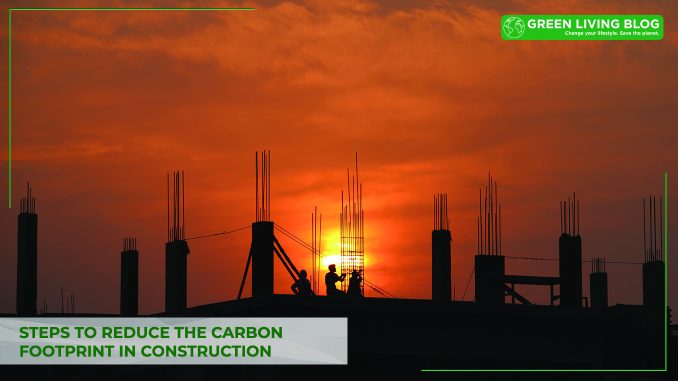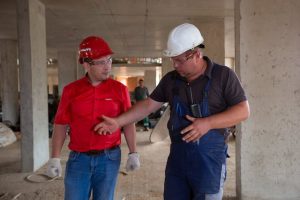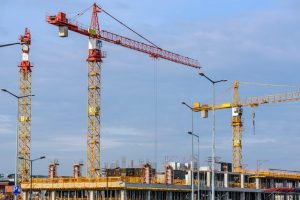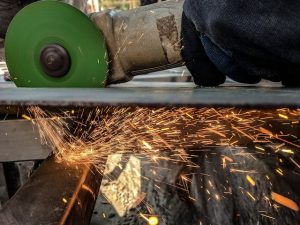
Let’s talk about the construction industry – it’s a big player in the global carbon emissions game.
From towering skyscrapers to sprawling residential complexes, construction shapes our world, but it also leaves a hefty carbon footprint. The reality is, that every time we build, we’re also contributing to greenhouse gas emissions.
That’s why there’s a growing buzz about sustainable construction. It’s not just a trend; it’s a necessity. Reducing the carbon footprint in construction is crucial for our planet’s health. We need to build, yes, but we also need to protect our environment.
It’s time to dive into how we can make construction greener and more sustainable. Let’s get started.
1. Understanding Carbon Footprint in Construction

What’s the Carbon Footprint in Building Stuff?
In construction, “carbon footprint” is all about the amount of greenhouse gases, especially carbon dioxide, that building stuff releases into the atmosphere. It’s like a measure of the environmental impact of a construction project, from start to finish.
Where’s All This Carbon Coming From?
Materials: Think about the stuff buildings are made of – concrete, steel, glass. Producing these materials often involves processes that emit a lot of carbon. For instance, making cement is a major contributor to carbon emissions in construction.
Machinery: Those big machines at construction sites? They’re usually running on fossil fuels. Excavators, cranes, trucks – they all burn fuel and release carbon dioxide.
Building Processes: The way we build also matters. From site preparation to the actual construction work, different stages of the building process add to the carbon footprint. Energy-intensive tasks, like welding and transporting materials, really add up in terms of emissions.
So, when we talk about reducing the carbon footprint in construction, we’re looking at making smarter choices with materials, using cleaner machinery, and tweaking building processes to be more eco-friendly. It’s about building in a way that’s better for our planet.
2. Energy-Efficient Construction Practices

Building Smarter, Not Harder
In the construction world, being energy-efficient is all about smart practices. It’s not just good for the planet; it saves money too. Let’s break down some key ways to make construction more energy-efficient.
Efficient Site Planning: A Game-Changer
First up, efficient site planning. This means thinking about the layout, orientation, and design of a building right from the start. It’s about maximizing natural light, using the landscape to your advantage, and reducing the need for artificial heating and cooling. Smart planning can significantly cut down energy use over a building’s lifetime.
Renewable Energy: The Power of Green
Then there’s renewable energy. Solar panels, wind turbines, and even geothermal systems are becoming more common on construction sites. These aren’t just for powering the finished building; they can be used during construction too, reducing reliance on traditional, polluting energy sources.
Tech to the Rescue
And let’s not forget technology. Modern construction is harnessing tech like never before to boost energy efficiency. We’re talking about software for better project management or decarbonisation management like Cool Planet, materials that provide better insulation, and machinery that’s more energy efficient. Even simple things like LED lighting on site can make a big difference.
In short, energy-efficient construction is about being clever with resources, from the drawing board to the final brick. It’s a smarter way to build for a greener future.
3. The Role of Green Technology in Construction

Tech Goes Green in Building Big
In the construction scene, green technology is the new cool kid on the block. It’s all about using innovative tech to cut down those pesky carbon emissions. Let’s dive into some of these game-changing technologies.
Electric Construction Vehicles: Quiet and Clean
First off, electric construction vehicles are making some serious noise (or rather, not making noise). These eco-friendly beasts do the same heavy lifting as their diesel-guzzling cousins but without a carbon footprint. They run quieter, and cleaner, and are starting to pop up on forward-thinking construction sites.
Advanced Insulation: Keeping It Cozy, Naturally
Then there’s advanced insulation. We’re not just talking pink fluffy stuff in the walls. Today’s insulation materials are high-tech, super-efficient, and sometimes even made from recycled or natural materials. They keep buildings cozy using less energy, which means lower heating and cooling emissions.
Real-World Examples: Green Tech in Action
So, where’s all this tech showing up? In loads of places. You’ve got skyscrapers with smart glass that adjusts to sunlight, reducing the need for air conditioning. Homes are being built with solar tiles right on their roofs, blending green energy with sleek design. And let’s not forget about those green roofs and walls – they’re like a slice of nature in the city, helping with insulation and air quality.
In short, green technology in construction isn’t just a fad; it’s the future. It’s about building smarter, cleaner, and more sustainable. And that’s something we can all get on board with.
4. Waste Reduction and Recycling in Construction

Cutting Down Waste: Good for the Planet and Your Wallet
Reducing waste, recycling, and reusing materials isn’t just eco-friendly – it’s smart business. Here’s how it’s done and why it matters:
Minimize, Recycle, Reuse
First, plan to minimize waste. This means ordering materials accurately, using prefabricated components, and being efficient in design. Less waste from the get-go means less to deal with later.
Recycling is next. Those heaps of unused materials? They can often be recycled. Metals, concrete, wood, and even certain plastics can get a second life, keeping them out of landfills and reducing the need for new materials.
And don’t forget about reuse. That old saying, “One man’s trash is another man’s treasure,” rings true in construction. Salvaged materials like bricks, tiles, and fixtures can add character to new projects and save them from the dump.
Why Bother?
Here’s why it’s worth the effort: environmentally, reducing waste means less landfill crowding and lower emissions from producing new materials. Economically, it can cut costs – recycled and reused materials are often cheaper, and efficient planning saves money on material orders.
In short, waste reduction and recycling in construction are about being resourceful and responsible. It’s a win-win for the environment and the bottom line.
Reducing the carbon footprint in construction isn’t just a nice-to-have; it’s essential for a sustainable future. Here’s the rundown of what we need to do:
Smart Materials: Choose sustainable building materials like recycled steel, bamboo, and reclaimed wood. They’re not just good for the planet; they’re great for building too.
Energy Efficiency: Embrace energy-efficient practices. From smart site planning to using renewable energy sources, every step counts.
Tech for the Win: Leverage green technology. Electric vehicles, advanced insulation, and high-tech building methods can slash emissions big time.
Reduce, Recycle, Reuse: Minimize waste at every turn. Recycle what you can and find new uses for old materials. It’s about being resourceful.
Adopting these strategies isn’t just about following trends. It’s about leading the charge toward a more responsible and sustainable construction industry. It’s about building not just for today, but for a better tomorrow. Let’s get building – the green way!
![]()
Author Profile

- Eco Warrior by day, Eco Blogger by night trying to get the eco balance right.
Latest entries
 BusinessMay 3, 2024The Role of automated Loading Solutions for Sustainability
BusinessMay 3, 2024The Role of automated Loading Solutions for Sustainability Green Living HomeApril 23, 20246 Ways to swap to a greener Car sooner
Green Living HomeApril 23, 20246 Ways to swap to a greener Car sooner BusinessApril 22, 2024How to Go Green and Paperless at the Office
BusinessApril 22, 2024How to Go Green and Paperless at the Office EnvironmentApril 3, 2024Create the Perfect Summer Garden attracting Wildlife with a Lush Lawn from Seed
EnvironmentApril 3, 2024Create the Perfect Summer Garden attracting Wildlife with a Lush Lawn from Seed





Leave a Reply
You must be logged in to post a comment.